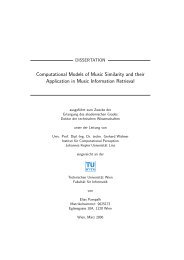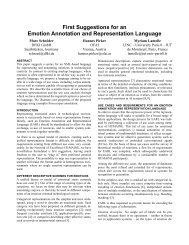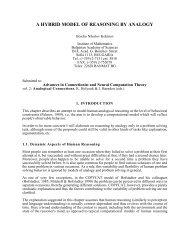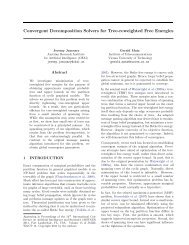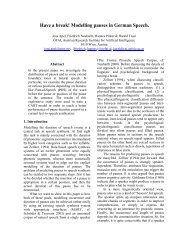Global Musical Tempo Transformations using Case Based ... - OFAI
Global Musical Tempo Transformations using Case Based ... - OFAI
Global Musical Tempo Transformations using Case Based ... - OFAI
You also want an ePaper? Increase the reach of your titles
YUMPU automatically turns print PDFs into web optimized ePapers that Google loves.
to select the best matching case or to rank the cases according to their<br />
relevancy. This method can be integrated with the initial match method,<br />
but it can also be treated as a separate method. The Select task usually<br />
involves a more detailed matching of the problem description of the cases to<br />
the input description. Ideally, the method should prefer those cases whose<br />
solutions offer the best starting point for generating the solution for the<br />
input problem. This can be done by assessing how relevant the differences<br />
between input description and problem description of the matched case are,<br />
for example by weighting the description features or the discriminatory power<br />
of the features.<br />
To continue the example from the previous subsection, we consider the selection,<br />
or rather ranking task as performed in <strong>Tempo</strong>-Express. The ranking<br />
is performed upon a number of matching cases returned by the match task.<br />
For each case the performance available at the input tempo T i is compared to<br />
the input performance by <strong>using</strong> a similarity measure for performances. The<br />
cases are ranked according to these similarities. The performance at T o of<br />
the best matching cases is taken as the input for the Reuse task.<br />
3.3.3 The Reuse Task<br />
The generation of the solution for the input problem based on the retrieved<br />
case(s) is defined as the Reuse task (also called adaptation). Since Reuse is<br />
generally considered a rather difficult task, that involves thorough knowledge<br />
of the problem domain, it is sometimes circumvented by increasing the size<br />
of the case base until most problems are represented in the case base. In that<br />
case, a solution for a new problem can be transferred literally, that is without<br />
adaptation, from the most similar (or preferably, identical) case in the case<br />
base to the new problem. Obviously, this approach is not feasible in most<br />
real life situations, since the number and variety of cases is too large. For<br />
these situations Reuse is a way of making problem solving tractable in two<br />
opposite ways. Firstly, it reduces the need for a huge case base that covers all<br />
conceivable problems and their solutions, since parts of the problem space<br />
can be covered by interpolating (through Reuse) from solutions of nearby<br />
problems. Secondly, it serves to reduce the computational effort needed to<br />
construct a solution (when compared to non-CBR approaches), by offering<br />
ways to use existing solutions to similar problems as a starting point, instead<br />
of starting from scratch.<br />
In the Reuse task, the central question is whether (parts of) the retrieved<br />
solution(s) can be reused in the new solution, and if so, whether those solutions<br />
need to be adapted to fit the requirements of the input description.<br />
There are several frameworks for building a new solution based on retrieved<br />
38




